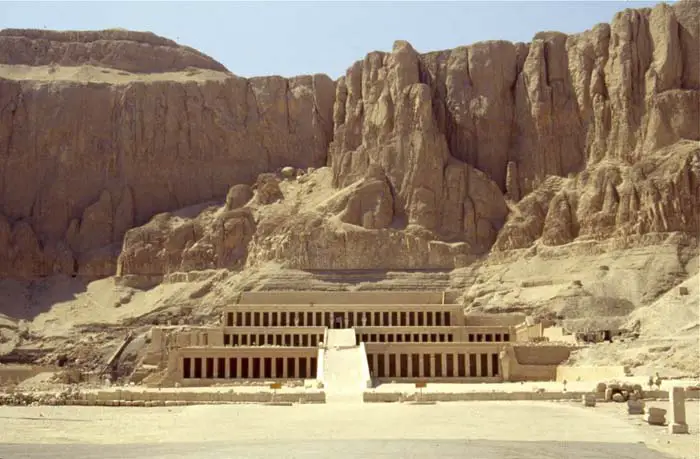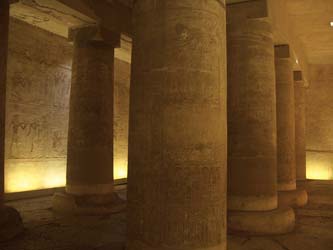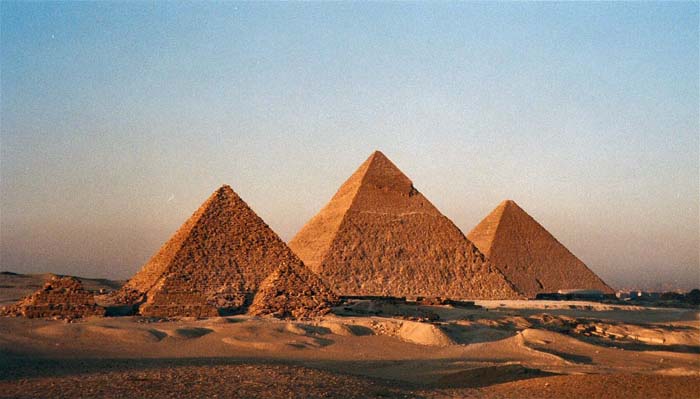Ancient Egyptian Architecture
Much of what makes Ancient Egypt such a memorable time and place is its architecture. The Ancient Egyptians left behind some of the most impressive buildings of the ancient world. Among them, of course, are the Pyramids of Giza, but they are only part of the picture.
History of Ancient Egyptian Architecture
Ancient Egypt itself dates back to roughly 3150 BCE. However, Ancient Egyptian architecture did not become what we think of today until roughly 2649 BCE. Structures that survived the Old Kingdom, which lasted until about 2150 BCE, include mastabas, the Great Pyramids and the Great Sphinx. All of these structures were built from stone.
The earliest example of a burial pyramid in Ancient Egypt was the step pyramid, which was stacked in such a way that the sides formed steps. The first known of these was the Pyramid of Djoser, designed by Djoser's vizier Imhotep and constructed around 2667 to 2648 BCE. This large structure, like those to come after it, was not a simple tomb. It was surrounded by a burial complex that contained other structures.

© Ed Yourdon - Djoser's Step Pyramid
The architects of the Old Kingdom eventually progressed to smooth-sided pyramids, like those found at Giza. These date back to around 2580 to 2560 BCE. The Great Sphinx that occupies the same plateau was built around 2558 to 2532 BCE, so near the same time, but not quite. While some believe the Sphinx houses tunnels beneath its massive feet and belly, it is likely an example of art rather than architecture, given that no such tunnels have been found.
The Middle Kingdom, which dates from 2055 BCE to 1650 BCE, saw the building of pyramids continue, but temples really dominate this period in the history of Ancient Egyptian architecture. Temples were built earlier, but very little of them have survived. Of the Middle Kingdom, much is left. Deir el-Bahari appeared across from modern-day Luxor. The great pylon towers that would mark the New Kingdom also began appearing in temples.

© Charlie Phillips - The Temple of Hatshepsut
The New Kingdom saw the construction of such great structures as the Luxor Temple, which is still magnificent today. Around this period (1550-1069 BCE) the Temple of Amon-Ra at Karnak also appeared. Colonnades, statuary and impressive entrances were very much in style. This style, and smooth facades, continued through the Late Period and the end of Ancient Egypt in about 332 BCE.
Characteristics of Ancient Egyptian Architecture
Most buildings in Ancient Egypt were made from Nile mud baked in the sun. However, the grandiose structures that people associate with Ancient Egypt were made from stone, which is why they lasted longer and make up the bulk of what we know of the characteristics of Ancient Egyptian architecture. The casings of the pyramids were white limestone or red granite. Other important structures, such as temples and palaces, did sometimes also include mud brick in their construction.
Smooth, largely unbroken walls were popular in Ancient Egypt. These were ornamented with brightly painted art and hieroglyphs. The thick, sloping walls and columns were used to hold up flat roofs of solid stone. Columns were also used in grand entrances and courtyards.

© isawnyu - The Osiris Complex at Abydos
Buildings in Ancient Egypt
There are hundreds of Ancient Egyptian sites and even more known buildings that no longer exist, such as the Library of Alexandria. The biggest and most significant sites today are considered monuments to Ancient Egyptian culture and include:
- The Great Pyramid of Giza – Easily the most famous structure of Ancient Egypt and the last surviving, and oldest, wonder of the ancient world, this pyramid was finished about 2540 BCE and was built for Pharaoh Khufu.
- The Luxor Temple – The Luxor Temple is a huge religious complex founded around 1400 BCE. In spite of the name, there are actually six major temples associated with Luxor, known in ancient times as Thebes.
- The Step Pyramid of Djoser – The Step Pyramid of Djoser was built between 2667 to 2648 BCE and is an earlier incarnation of the popular pyramid tombs of the great pharaohs.
- The Temple of Hatshepsut – This mortuary temple was designed by the queen's architect Senenmut in the 15th century BCE and is part of Deir el-Bahari. Click here to discover more about The Temple of Hatshepsut
- The Royal Tombs of the Valley of the Kings – There are more than 60 known tombs in the Valley of the Kings, all built at different times for different rulers.
- The Temple of Karnak – The Temple of Karnak is massive and exists outside of the modern cities, unlike other important buildings from Ancient Egypt. It has several sections which have been deconstructed, reconstructed and/or built around over the course of thousands of years. Only the section dedicated to Amon-Ra is currently open to the public.
- Abu Simbel – Abu Simbel is home to two temples, one to Nefertari and the other to Ramses II, which were constructed between 1264 and 1244 BCE.

© Bruno Girin - The pyramids of Khufu, Khafre and Menkaure
Interesting Facts About Ancient Egyptian Architecture
- Ancient Egyptians would often build structures to align with the sun in some way. For example, the main chamber of the Temple of Ramses II at Abu Simbel was designed to light up only twice a year, on the date of his coronation and his birthday.
- The polished white limestone casing stones of the Great Pyramid of Giza are mostly gone. Between an earthquake and use by later rulers for their own construction, there are very few left on the pyramid itself.
- In spite of a growing body of artifacts from around the Great Pyramid, it is still unknown precisely how the gigantic structure was built and how ancient workers moved the stones into place.
